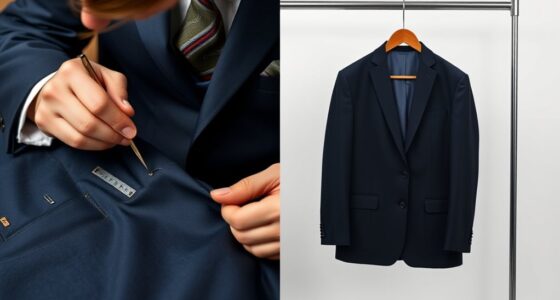Luxury brands reinvent classic styles by blending heritage craftsmanship with modern design, innovative fabrics, and sustainable materials. They update traditional silhouettes with contemporary twists, like oversized coats or asymmetric hems, while incorporating smart textiles and eco-friendly textiles. Collaborations and limited editions create exclusivity that appeals to new and loyal customers. Trends like digital customization and virtual showrooms signal future directions. Keep exploring to discover how these transformations shape the future of high fashion.
Key Takeaways
- Heritage brands reinterpret classic styles with modern design elements, innovative fabrics, and sustainable practices to appeal to contemporary consumers.
- Use of cutting-edge textiles and eco-friendly materials transforms traditional garments into durable, eco-conscious luxury pieces.
- Integration of wearable technology and advanced craftsmanship techniques enhances functionality and innovation in classic designs.
- Collaborations and limited editions create exclusivity, storytelling, and increased desirability for reimagined heritage styles.
- Future trends focus on AI personalization, digital influence, and immersive experiences to continually reinvent luxury fashion.
The Evolution of Heritage: From Classic to Contemporary

Heritage brands have long celebrated their roots, but today, they actively reinterpret their classic styles to fit modern tastes. This shift reflects a focus on heritage preservation, ensuring that traditional craftsmanship and timeless designs stay relevant. By blending vintage revival with contemporary aesthetics, brands create pieces that honor their history while appealing to today’s fashion sensibilities. You’ll notice how these brands preserve iconic details, like intricate stitching or vintage-inspired silhouettes, but update them with fresh colors, modern fits, or subtle styling tweaks. This approach allows them to maintain authenticity while staying current. Incorporating modern design elements helps these brands appeal to a broader, more diverse audience. Additionally, emphasizing sustainable practices aligns heritage pieces with the values of contemporary consumers, securing their relevance in today’s fashion landscape. Staying informed about industry trends and innovative techniques can further support brands in evolving their collections effectively.
Innovative Fabrics and Materials Transforming Traditional Looks

You can see how luxury brands are reshaping classic styles with innovative fabrics that prioritize sustainability and performance. These cutting-edge materials, like eco-friendly textiles and smart fabrics, add new dimensions to traditional designs. As a result, your wardrobe becomes not only stylish but also more aligned with modern technology and environmental values. Understanding the materials and craftsmanship behind these innovations helps consumers appreciate the true value of luxury redesigns. Furthermore, the integration of advanced textile technologies enables designers to create more durable and functional clothing that meets contemporary needs, including high-tech fabrics that adapt to different conditions and preferences. Incorporating specialized manufacturing processes ensures these innovative textiles are produced with precision and care, enhancing their overall quality and longevity. Exploring sustainable textile innovations reveals how environmental considerations are shaping the future of luxury fashion.
Sustainable Fabric Innovations
Have innovative fabrics truly revolutionized traditional luxury styles? Many brands are now turning to sustainable fabric innovations to do just that. You’ll notice the shift toward plant-based dyes, which offer vibrant colors without harmful chemicals, reducing environmental impact. Biodegradable textiles are also gaining popularity, allowing garments to decompose naturally after use, cutting down on waste. These materials help preserve the environment while maintaining high-quality aesthetics. Additionally, incorporating natural materials like wood, stone, and linen enhances the authenticity of the designs and aligns with eco-friendly principles. The integration of eco-conscious practices in manufacturing further supports sustainability efforts within the industry. The use of trusted custodians for managing sustainable collections ensures transparency and accountability in sourcing and production. Luxury brands are blending classic designs with eco-friendly fabrics, creating timeless pieces that align with modern values. By adopting these sustainable innovations, you’re part of a movement that redefines elegance—one that respects both tradition and the planet. This shift proves that luxury doesn’t have to come at the expense of sustainability, especially when considering the environmental impacts of materials. Additionally, the focus on sustainable sourcing helps to ensure that these fabrics are produced responsibly from start to finish.
Tech-Infused Material Advances
Innovative fabrics infused with advanced technology are pushing the boundaries of traditional luxury styles. You’ll find wearable tech integrated seamlessly into high-end garments, creating designs that are both functional and fashionable. Smart textiles now offer features like temperature regulation, moisture-wicking, and even embedded lighting, elevating classic looks with modern convenience. The use of smart textiles allows for customization and interactivity, transforming simple silhouettes into interactive pieces. As a result, you can enjoy clothing that adapts to your environment while maintaining a sophisticated aesthetic. Additionally, the integration of Audi Tuning techniques into fabric design is opening new avenues for dynamic and customizable luxury apparel. This fusion of innovation and tradition ensures luxury fashion stays relevant in a tech-driven world, enthralling those who seek both style and cutting-edge functionality. The ongoing development of wearable technology continues to redefine what luxury garments can achieve, blending fashion with technological innovation. Incorporating advanced materials also contributes to sustainability efforts by reducing waste and enhancing garment durability. Furthermore, smart textiles are increasingly being used to improve comfort and performance in luxury clothing.
Cutting-Edge Techniques: Redefining Craftsmanship in Modern Fashion

As fashion houses embrace new technologies, they’re transforming traditional craftsmanship into a dynamic art form. Digital tailoring allows you to customize fits precisely, reducing waste and enhancing comfort. Instead of relying solely on manual skills, designers now use software to create perfect patterns tailored to individual measurements. 3D printing takes innovation further by producing intricate accessories and even garment components with remarkable precision. You can see this in the way luxury brands craft complex embellishments or unique textures that were once impossible by hand. These cutting-edge techniques streamline production while elevating quality, giving you a product that’s not only innovative but also meticulously crafted. By merging technology with artisanal skill, fashion brands are redefining what craftsmanship means in the modern era. Additionally, hosting hackathons enables brands to collaborate with diverse talent pools, fostering continuous innovation in design and production methods. Furthermore, integrating digital manufacturing processes helps brands achieve higher levels of customization and sustainability.
Iconic Silhouettes Reimagined for the New Generation

By combining cutting-edge craftsmanship with bold new designs, luxury brands are reimagining iconic silhouettes to appeal to today’s generation. They tweak classic shapes—like the A-line dress or tailored blazer—adding daring elements like exaggerated proportions or unexpected textures. Bold branding plays a key role, with logos subtly integrated into modern forms, making heritage storytelling more personal. These reinterpretations honor tradition while embracing innovation, creating silhouettes that feel fresh yet familiar. Below is a glimpse of these transformations:
| Original Silhouette | Modern Twist | Key Feature |
|---|---|---|
| Classic Trench Coat | Oversized with bold branding | Heritage storytelling |
| Pencil Skirt | Asymmetric hem with textured fabric | Modern edge |
| Brogue Shoes | Chunky sole, innovative materials | Reimagined tradition |
This approach keeps iconic styles relevant, engaging a new generation without losing their essence.
Collaborations and Limited Editions: Bridging Past and Present

Collaborations and limited editions create excitement by blending iconic styles with fresh perspectives. They generate buzz among enthusiasts and collectors alike. As a result, demand surges, making these pieces highly sought after.
Exclusive Collaborations Spark Buzz
Luxury brands are creating buzz by teaming up with designers, artists, and celebrities to produce limited-edition collections. These brand partnerships leverage market exclusivity to attract attention and elevate desirability. When you see a collaboration, it’s not just about the product; it’s about the story and the sense of rarity it offers. These exclusive collaborations generate immediate excitement, making consumers enthusiastic to own something unique. By combining their heritage with fresh, modern influences, brands bridge past and present seamlessly. The scarcity created through limited runs fuels demand, ensuring your desire for these pieces remains high. This strategy taps into the thrill of owning something truly rare, reinforcing the brand’s elite status and keeping them at the forefront of high fashion.
Limited Editions Drive Demand
Limited editions amplify the excitement created by exclusive collaborations, turning rarity into a powerful driver of demand. When luxury brands release limited runs, they tap into heritage storytelling, emphasizing their rich history while appealing to modern consumers. These carefully curated collections create a sense of urgency, making items more desirable. To understand their impact, consider this table:
| Aspect | Benefit | Example |
|---|---|---|
| Scarcity | Boosts exclusivity and desirability | Limited designer bags |
| Heritage storytelling | Connects past with present, enriching brand value | Reissue of vintage styles |
| Brand loyalty | Encourages repeat purchases | Special edition sneakers |
| Market appeal | Attracts collectors and new audiences | Collaborations with artists |
| Value retention | Maintains or increases resale value | Rare collectibles |
Sustainability Meets Tradition: Eco-Friendly Twists on Timeless Styles

As designers seek to honor tradition while addressing modern concerns, eco-friendly innovations are transforming classic styles into sustainable statements. Upcycling initiatives play a key role, allowing you to breathe new life into vintage fabrics and leftover materials, reducing waste while maintaining timeless appeal. Brands embracing eco conscious branding highlight their commitment to sustainability, making it a core part of their identity. You’ll see luxury labels reimagining iconic designs with environmentally friendly materials, blending history with responsibility. These efforts not only preserve craftsmanship but also appeal to conscious consumers who value eco-awareness alongside heritage. By integrating sustainable practices into classic styles, you’re part of a movement that respects tradition while actively reducing environmental impact, proving that luxury and sustainability can coexist beautifully.
Future Trends: The Next Chapter in Luxury Fashion Reinventions

The future of luxury fashion lies in innovative reinventions that seamlessly blend technology, sustainability, and personalization. Digital influence will drive more immersive experiences, such as virtual try-ons and augmented reality showrooms. This shift enhances engagement and broadens reach. Additionally, global expansion will accelerate, as brands leverage online platforms to access emerging markets. To stay ahead, consider these key trends:
Luxury fashion evolves through tech-driven, sustainable, and personalized innovations, expanding reach via immersive virtual experiences and global digital growth.
- Integrating AI for customized designs that reflect individual preferences.
- Expanding digital influence through social media and influencer collaborations.
- Utilizing virtual spaces to create exclusive, globally accessible experiences.
Frequently Asked Questions
How Do Luxury Brands Preserve Heritage While Innovating Designs?
You preserve heritage by respecting traditional craftsmanship and iconic elements, ensuring they remain recognizable. At the same time, you embrace design innovation by experimenting with modern materials, silhouettes, and techniques. Luxury brands blend the old with the new, honoring their roots while appealing to contemporary tastes. This balance allows you to maintain authenticity through heritage preservation, while enthralling audiences with fresh, innovative designs that push fashion boundaries.
What Sustainable Practices Are Integrated Into Luxury Fashion Reinventing Classic Styles?
Imagine a lush green forest where every leaf tells a story—luxury brands bring this to life through sustainable practices. You’ll see eco-friendly materials woven into modern designs, symbolizing harmony with nature. Ethical sourcing guarantees each piece supports fair labor and preserves traditions. By blending innovation with responsibility, you help redefine classic styles into timeless, eco-conscious masterpieces, making luxury fashion a symbol of beauty that respects the planet and its people.
How Do Collaborations Influence the Evolution of Iconic Luxury Pieces?
Designer collaborations and limited editions markedly influence the evolution of iconic luxury pieces by blending unique perspectives with brand heritage. When you experience these collaborations, you see fresh takes on classic styles, making them more relevant and desirable. Limited editions create exclusivity, encouraging you to act quickly. This dynamic approach keeps luxury fashion innovative and exciting, constantly redefining what makes an iconic piece timeless while appealing to your desire for originality and rarity.
In What Ways Are Traditional Craftsmanship Techniques Adapted for Modern Manufacturing?
You see traditional craftsmanship techniques like embroidery techniques and leather tooling adapted for modern manufacturing by combining hand skills with advanced technology. Designers use embroidery techniques to add intricate details efficiently, while leather tooling is streamlined with precision machinery. This blend preserves the artisanal quality, yet speeds up production, allowing you to enjoy luxury pieces that maintain their craftsmanship integrity while fitting contemporary demands.
What Emerging Technologies Are Shaping the Future of High-Fashion Redesigns?
You’ll find that digital textiles and AI patterning are transforming high-fashion redesigns. Digital textiles allow you to experiment with innovative fabrics and intricate designs virtually, reducing waste. Meanwhile, AI patterning helps you create unique, customized patterns rapidly and accurately. These emerging technologies enable you to push creative boundaries, making classic styles feel fresh and modern while optimizing production and sustainability. They’re shaping the future of high-fashion with unprecedented precision and innovation.
Conclusion
As you see, luxury brands are truly turning the tables by blending tradition with innovation. They’re not just resting on their laurels but pushing boundaries to stay ahead of the curve. With new fabrics, techniques, and sustainable twists, they’re proving that old dogs can learn new tricks. Keep an eye out—these reinventions show that the sky’s the limit, and in fashion, the only constant is change. The future’s looking brighter than ever.









